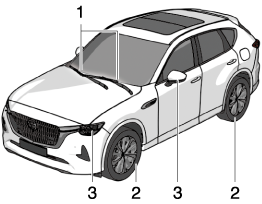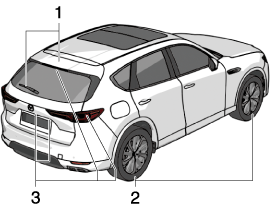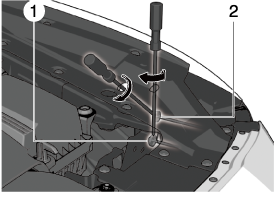Vehicle Exterior Inspection
Checking the Inspection Locations and Inspection Items
Front

Rear

-
Windshield wipers
-
Tires
-
Light bulbs
Replacing Windshield Wiper Blade Rubbers
-
Hot waxes applied by automatic car washers have been known to affect the wiper's ability to clean windows.
-
An operation malfunction may occur or the wiper effectiveness may be reduced if a water-repellent coating is used.
-
To prevent damage to the wiper blades, do not use gasoline, kerosene, paint thinner, or other solvents on or near them.
-
When the wiper lever is in the AUTO position and the vehicle power is switched ON, the wipers may move automatically in the following cases:
-
If the windshield above the rain sensor is touched.
-
If the windshield above the rain sensor is wiped with a cloth.
-
If the windshield is struck with a hand or other object.
-
If the rain sensor is struck with a hand or other object from inside the vehicle.
Be careful not to pinch hands or fingers as it may cause injury, or damage the wipers. When washing or servicing the vehicle, make sure the wiper lever is in the OFF position.
-
-
Before lifting the windshield wiper blades off the windshield, always follow the procedure for moving the windshield wiper blades. Otherwise, a wiper blade, wiper arm, or the hood could be damaged.
Contamination of either the windshield or the blades with foreign matter can reduce wiper effectiveness. Common sources are insects, tree sap, and hot wax treatments used by some commercial car washes.
If the blades are not wiping properly, clean the window and blades with a good cleaner or mild detergent; then rinse thoroughly with clean water. Repeat if necessary.
You can replace the wiper blades yourself, however you cannot replace the wiper arms.
If you want to replace the wiper arms, consult an Authorized Mazda Dealer.
Replacing Front Windshield Wiper Blade rubbers
-
Move the wipers to the service positions using the following procedure.
-
Switch the vehicle power ON.
-
Switch the vehicle power OFF.
-
Press up the wiper switch to the MIST position 2 times within 30 seconds after switching the vehicle power OFF.
When the procedure is completed, the wipers operate and they stop at the service positions.
-
-
Raise the wiper arms.
-
Slide the blade component in the direction of the arrow while pressing the wiper arm tab to remove the blade component from the wiper arm.





-
Make sure that the blade rubber is correctly installed to the blade holder.

-
Slowly lower the wiper arms onto the windshield.
To prevent damage to the windshield let the wiper arm down easily, do not let it slap down on the windshield.
-
Move the wipers to their initial positions using the following procedure.
-
Make sure that the wipers are set on the windshield.
-
Switch the vehicle power ON.
-
Press up the wiper switch to the MIST position 2 times.
-
Replacing Rear Windshield Wiper Blade rubber
To prevent damage to the wiper arm and other components, do not move the wiper by hand.
-
Open the cover.

-
Raise the wiper arm and rotate the wiper blade to the right until it unlocks, then remove the blade.

To prevent damage to the rear window, do not let the wiper arm fall on it.

-
Remove the metal stiffeners from the blade rubber and install them in the new blade rubber.


-
Install the blade assembly in the reverse order of removal.
Inspecting the Tires
About Tires
For reasons of proper performance, safety, and better energy efficiency, always maintain recommended tire inflation pressures and stay within the recommended load limits and weight distribution.
Using Different Tire Types.
Driving your vehicle with different types of tires is dangerous. It could cause poor handling and poor braking; leading to loss of control.
Except for the limited use of the temporary spare tire, use only the same type tires (radial, bias-belted, bias-type) on all four wheels.
Using Wrong-Sized Tires.
Using any other tire size than what is specified for the vehicle (Search)is dangerous. It could seriously affect ride, handling, ground clearance, tire clearance, and speedometer calibration. This could cause you to have an accident. Use only tires that are the correct size specified for the vehicle.
Inspecting tire inflation pressure
Always inflate the tires to the correct pressure.
Overinflation or underinflation of tires is dangerous. Adverse handling or unexpected tire failure could result in a serious accident.
Refer to Tires (Search).
Use only a Mazda-genuine tire valve cap.
Use of a non-genuine part is dangerous as the correct tire air pressure cannot be maintained if the tire valve becomes damaged. If the vehicle is driven under this condition, the tire air pressure will decrease which could result in a serious accident. Do not use any part for the tire valve cap that is not a Mazda-genuine part.
Inspect all tire pressures monthly (including the spare) when the tires are cold. Maintain recommended pressures for the best ride, handling, and minimum tire wear.
Refer to the specification charts (Search).
-
Cold inflation pressure
The cold inflation pressure is the pressure measured under ambient temperatures before the vehicle is driven.
-
Maximum inflation pressure
The maximum inflation pressure is the upper limit of the cold inflation pressure designated by the tire manufacturer.
-
Recommended inflation pressure
The recommended inflation pressure is the cold inflation pressure necessary for maintaining the performance of your Mazda.
-
Underinflation or overinflation can cause a harsh ride, reduced fuel economy, a greater possibility of damage from road hazards, uneven and accelerated tire wear, and poor sealing of the tire bead, which will deform the wheel and cause separation of tire from rim.
-
Keep your tire pressure at the correct levels. If one frequently needs inflating, have it inspected.
Rotating the Tires
Rotate tires periodically.
Irregular tire wear is dangerous. To equalize tread wear for maintaining good performance in handling and braking, rotate the tires periodically or sooner if irregular wear develops.
Please refer to Scheduled maintenance for your tire rotation interval.
During rotation, inspect them for correct balance.

Do not include (TEMPORARY USE ONLY) spare tire in rotation.
Also, inspect them for uneven wear and damage. Abnormal wear is usually caused by one or a combination of the following:
-
Incorrect tire pressure
-
Improper wheel alignment
-
Out-of-balance wheel
-
Severe braking
After rotation, inflate all tire pressures to specification (Search) and inspect the lug nuts for tightness.
Rotate unidirectional tires and radial tires that have an asymmetrical tread pattern or studs only from front to rear, not from side to side. Tire performance will be reduced if rotated from side to side.
Replacing a Tire or a Wheel
Always use tires that are in good condition.
Driving with worn tires is dangerous. Reduced braking, steering, and traction could result in an accident.
Replace all four tires at the same time.
Replacing just one tire is dangerous. It could cause poor handling and poor braking resulting in loss of vehicle control. Mazda strongly recommends that you replace all four tires at the same time.
Always use wheels of the correct size on your vehicle.
Using a wrong-sized wheel is dangerous. Braking and handling could be affected, leading to loss of control and an accident.
A wrong-sized wheel may adversely affect:
-
Tire fit
-
Wheel and bearing life
-
Ground clearance
-
Snow-chain clearance
-
Speedometer calibration
-
Headlight aim
-
Bumper height
-
Tire Pressure Monitoring System
If a tire wears evenly, a wear indicator will appear as a solid band across the tread.
Replace the tire when this happens.

-
New tread
-
Worn tread
-
Tread wear indicator
You should replace the tire before the band crosses the entire tread.
Tires degrade over time, even when they are not being used on the road. It is recommended that tires generally be replaced when they are 6 years or older. Heat caused by hot climates or frequent high loading conditions can accelerate the aging process. You should replace the spare tire when you replace the other road tires due to the aging of the spare tire. The period in which the tire was manufactured (both week and year) is indicated by a 4-digit number.
Refer to Tire Labeling (Search).
Replacing Light Bulbs
All the light bulbs are the LED type.
The LED bulb cannot be replaced as a single unit because it is an integrated unit.
The LED bulb has to be replaced with the unit. If a replacement is necessary, consult an Authorized Mazda Dealer.
Adjusting the Headlight Aim
If the headlight cannot be adjusted using procedure below, consult an Authorized Mazda Dealer.
-
Make sure the vehicle has a full tank of gasoline and the area around the headlight is not deformed.
-
Park the vehicle on level ground.
-
Sit in the driver's seat.
-
Bounce the vehicle several times.
-
Using a Phillips-head screw-driver, turn bolt A in either direction. Remember the turning direction and the number of turns.
-
Turn bolt B the same number of turns and in the same direction as step 5.

-
Adjustment bolt A
-
Adjustment bolt B
















































